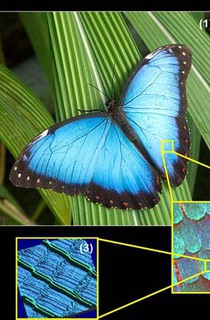Blue Morph
Blue Morph externalizes the nanoscale images and sounds from the metamorphosis of a caterpillar into a butterfly into an interactive installation. What was previously silent, is amplified. The audience have to be still and silent to witness the visualized and sonified installation.
Overview
Often in technology, biological information gets overlooked as we seek the quantitative answers relayed through pixels and CCDs. Yet in these bio-signals themselves is encoded a rich layer of multimedia encodings. Blue Morph externalizes the nanoscale images and sounds from the metamorphosis of a caterpillar into a butterfly into an interactive installation. Along with it, comes a host of the naturally unpleasant sounds of cellular transformation. What was previously silent, is amplified. The audience, previously noisy, have to be still and silent to witness the visualized and sonified installation.
Concept
Blue Morph is an interactive installation that uses nanoscale images and sounds derived from the metamorphosis of a caterpillar into a butterfly.
Nanotechnology is changing our perception of life and this is symbolic in the Blue Morpho butterfly with the optics involved -- that beautiful blue color is not pigment at all but patterns and structure which is what nano-photonics is centered on studying. The lamellate structure of their wing scales has been studied as a model in the development of fabrics, dye-free paints, and anti-counterfeit technology such as that used in monetary currency. Blue Morpho has intrigued scientists for generations because of its subtle optical engineering that manipulated photons. Today, its dazzling iridescent wings are giving rise to a market trying to mimic its wonder and create a counterfeit proof currency and credit cards. The optics are no doubt fascinating but the real surprise is in the discovery of the way cellular change takes place in a butterfly. Sounds of metamorphosis are not gradual or even that pleasant as we would imagine it. Rather the cellular transformation happens in sudden surges that are broken up with stillness and silence. Then there are the eight pumps or "hearts" that remain constant throughout the changes, pumping the rhythm in the background. During the transformation to emergence each flattened cell of the wing becomes a nanophotonic structure of black protein and space leading to iridescence.
Nano is not only making the invisible visible but also changing our way of relating to "silence" or making the in-audible audible. With all the noise of chattering technologies and minds, we propose the interactivity to be stillness for in this empty space of nano we can get in touch with the magic of continuous change. But most of all we embrace the absurd and in a surge of laughter recognize our limited human viewpoints.
Blue Morph has been shown at a number of international venues including the 18th ACM International Conference on Multimedia between Oct 25 - 29 in Florence, Italy.
More information and further reading can be found at: http://artsci.ucla.edu/BlueMorph
No comments yet. Why not add the first?
Acknowledgements & Credits
BLUE MORPH is a collaboration between media artist Victoria Vesna and nanoscientist James Gimzewski featured at ACM MM 2010
CREDITS
This project would not be possible without the generous support of the Bermant foundation.
2010-11
Thanks to Carol Parkinson and staff at HarvestworksSurround sound / interactivity: Paul GelusoInteractive seat construction: Romie Littrell
2007-09
Installation design, Governor’s Island: Aliki Potiris Production: Shaun Westbrook, Tyler Adams, Laura Hernandez, Sara Cross
Photo Documentation: Adam Stieg, Brenda Williams, Yuta Nakayama
Thanks to Don Kania, CEO of FEI for allowing us to image the butterfly wings with their electron microscopes.
Morpho peleides and Danaus plexippus wings and pupa were provided by Dr. Richard Stringer Department of Math, Science and Allied Health, Harrisburg Area Community College.
Additional technical assistance of Andrew Pelling and Paul Wilkinson in recording the heart beat of Danaus plexippus chrysalis are kindly acknowledged.

← Back to work
0 Comments